Review of Pride FC: Middleweight Grand Prix 2003 (Four Discs)
Introduction
Spanning over two separate events in "Total Elimination" and "Final Conflict", the PRIDE Middleweight Grand Prix 2003 looked on paper to be perhaps the greatest tournament in mixed martial arts (MMA) history. Contesting the tournament were such standout fighters as Middleweight champion Wanderlei Silva, Kazushi Sakuraba, Hidehiko Yoshida, Quinton "Rampage" Jackson, and UFC representative Chuck Liddell, meaning that fans were guaranteed some mouth-watering match-ups on the way to, and in, the finals.
But as tremendous as the Middleweight tournament appeared to be, there was huge interest in the Heavyweight division at both Total Elimination and Final Conflict. In the former, undefeated Heavyweight champion Fedor Emelianenko faced Gary Goodridge in a bout which many hoped would lead to Fedor defending against Mirko CroCop, who himself faced Igor Vovchanchyn. CroCop (real name Mirko Filipovic) had been on a tear since switching from K-1 (which relies heavily on kickboxing) to MMA, often displaying his unparalleled kicking ability, and it was widely thought that he was the only man capable of subduing Fedor.
Presented to us on four discs by FightDVD, we are treated to two discs of extras, as well as the events themselves. Total Elimination took place on 10th August 2003 from the Saitama Super Arena in Saitama, Japan, and Final Conflict took place on 9th November 2003, from the famed Tokyo Dome in Tokyo, Japan.

Video
Video is presented in 4:3 fullscreen PAL, and is very good for a DVD of this genre. The image is ever-so-slightly soft, which is a legacy of this event`s NTSC origins. This is in no way distracting however, and this remains an excellent transfer, with no digital artefacts noticeable. The PRIDE production values, which in the opening ceremony at least, are beyond anything seen in even WWE wrestling, help to make these events feel truly spectacular.

Audio
Audio is presented in Dolby Digital 2.0, and also is generally very good. The audio is well-mixed, so that the audience, the in-ring action, and commentary (provided by Damon Perry and Bas Rutten) is all easily audible over the other. If you have yet to experience a PRIDE show, you will quickly note the differences between the American (UFC) and Japanese audiences. The Japanese audience are mostly very quiet during the bouts, only applauding a piece of skill, or showing partisanship if a Japanese fighter is on the verge of victory. It is a wonderful change from the Western norm, and an insight into the Japanese culture, too.
Unfortunately, there are some audio errors throughout this set, meaning that there are several seconds-long audio dropouts. These are particularly noticeable in the Antonio Rodrigo Nogueira vs. Mirko CroCop bout at Final Conflict 2003. The dropouts aren`t lengthy enough to spoil the experience of the show, but given the consistency of previous PRIDE releases, I`m surprised that they slipped through the screening process.
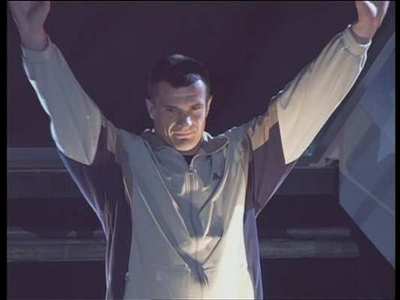
Features
With two of the four discs dedicated to extra material, with supplements on the main feature discs as well, the Middleweight Grand Prix 2003 set goes far beyond just showing the various fights.
Things begin on Disc One, with a glossary of fight terms, and a text look at the rules of PRIDE. There are also some basic fighter biographies, which, like the glossary and rules, are great for the first-time viewer. Also on Disc One is a selection of images from Total Elimination, some of which really catch great moments of action.
Disc Two features uncut interviews with many of the event participants. Sections of these were spliced into the main feature, but these uncut versions are still worth a look as a means of learning more about the personalities involved. There are also two music videos available, one featuring the quite spectacular fighter entrances, and the other highlighting the company`s ring girls. There is an "All Access" feature, which goes behind the scenes of Total Elimination, including visiting the press conference, where some interesting comments are made concering Chuck Liddell, and the UFC`s participation in the tournament. Also included is the "Countdown" show, which was designed to entice people to buy this event on American pay-per-view. There is a lot of excellent footage there, which makes it a nice extra to have. A short commercial for the event finishes things up.
Disc Three contains the same type of extras as Disc One, with the photo gallery, bios, and event poster. Naturally, all are specific to Final Conflict 2003.
Similarly, Disc Four follows the pattern of Disc Two, with uncut fighter interviews, an All Access feature, and music videos of the fighter entrances and ring girls, this time from the Final Conflict event. There is also a short commerical for the American pay-per-view broadcast, although the Countdown special has here been replaced with footage from a press conference regarding the PRIDE video game. Disc Four also contains a bonus match, as Heath Herring takes on Yoshihisa Yamamoto, though sadly, it is little to get excited about.
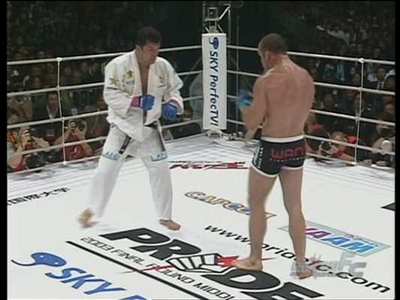
Conclusion
While the main focus of both Total Elimination and Final Conflict was the Middleweight Grand Prix tournament, it would not be wise to skip the cards` other bouts, such as the opening Total Elimination contest between Heavyweight champion Fedor Emelianenko and noted kick boxer Gary Goodridge. This bout was evidently designed to start proceedings with a knockout win, and it certainly delivered, in typically devastating fashion.
Quickly skipping ahead of two tournament bouts (which I will come back to later), the next "regular" match saw Antonio Rodrigo Nogueira face Ricco Rodriguez. This bout was particularly interesting because Rodriguez had previously defeated Nogueira in a submissions-only match outside of MMA, and that intrigue made for an excellent match, perhaps one of the best mat-based matches I`ve seen. Both men showed incredible technique, and proved that ju-jitsu orientated bouts have a place in the sport.
Total Elimination`s final "regular" bout saw Mirko CroCop face Igor Vovchanchyn, in a short stand-up bout which featured a quite stunning ending.
On to Final Conflict then, which once again began with "Big Daddy" (thankfully, no relation to Shirley Crabtree) Gary Goodridge, as he faced Dan Bobish. This was a short bout which was notable only for a controversial finish.
Another bout which was lacking somewhat was surprisingly the one which was contested by crowd favourite Kazushi Sakuraba. Sakuraba came to the ring with one of the most creative entrances ever witnessed in PRIDE (which is saying something), but his bout here with Kevin Randleman was remarkably uneventful. Randleman seemed keen to work at a slower pace than usual, which doesn`t suit his explosive style, and this bout suffered badly for that.
As previously noted, Final Conflict 2003 was originally scheduled to be the event at which Mirko CroCop finally ended his chase of Heavyweight champion Fedor Emelianenko, but a hand injury sadly caused the bout`s cancellation. All was not lost, though, as Antonio Rodrigo Nogueira stepped into the broach, contesting an incredible bout against the Croatian. With CroCop`s incredible knockout ability, and Nogueira`s superb ju-jitsu, this was a battle of wits as much as anything, and it certainly did not disappoint, with some brutal striking on show, leading to a spectacular finish. For that, this is a bout which has much repeat viewing.
All of this brings us back to the beginning, to look at the Grand Prix tournament itself, which unquestionably lived up to its billing as the best tournament in the history of the entire sport. To avoid spoilers, I won`t go into the details of each bout, but every encounter in the tournament itself is certainly worthy of viewing attention. There are no poor bouts, and indeed, there are some stormers available here, with Wanderlei Silva in particular notable for being involved in more than one superb contest. Other combatants worthy of applause are Quinton "Rampage" Jackson and Hidehiko Yoshida, the latter the cause of several moments of crowd hysteria, particularly when he faces off against non-Japanese opposition.
With seven out of fourteen bouts on this set being worth going out of your way to watch, the PRIDE Middleweight Grand Prix 2003 is a four-disc set that every fan will want to own. It is the perfect introduction to the now-defunct PRIDE promotion, or likewise a keepsake of what was a very special time in the short history of mixed martial arts.
Highly recommended.

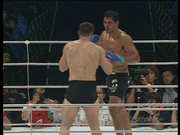
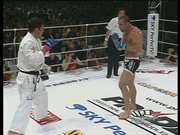



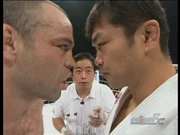




























Your Opinions and Comments
Be the first to post a comment!